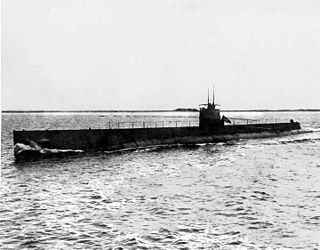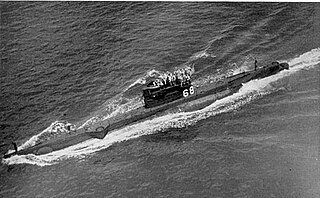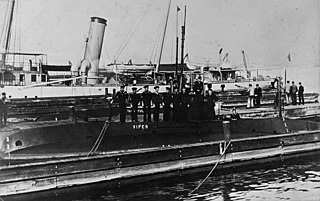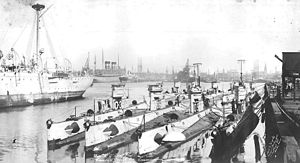
USS O-9 (SS-70) was an O-class submarine of the United States Navy.

The V-boats were a group of nine United States Navy submarines built between World War I and World War II from 1921 to 1934 under authorization as the "fleet boat" program.

The AA-1 class was a class of three experimental submarines of the United States Navy, built toward the end of World War I, between 1916 and 1919, intended to produce a high-speed fleet submarine. The design was not a success and none of the submarines saw active service. However, the lessons learned were applied to the design of the later V-boats. The class was later renamed as the T class.

The United States' S-class submarines, often simply called S-boats, were the first class of submarines with a significant number built to United States Navy designs. They made up the bulk of the USN submarine service in the interwar years and could be found in every theater of operations. While not considered "Fleet Submarines" in the traditional sense of that term, they were the first submarines in the USN designed for open ocean, blue water operations. All previous submarines had been intended for harbor or coastal defense. These boats were intended to have greater speed and range than previous classes, with improved habitability and greater armament.

USS O-2 (SS-63) was one of 16 O-class submarines built for the United States Navy during World War I.

USS O-4 (SS-65) was one of 16 O-class submarines built for the United States Navy during World War I.

USS O-7 (SS-68) was one of 16 O-class submarines built for the United States Navy during World War I.

USS O-8 (SS-69) was one of 16 O-class submarines built for the United States Navy during World War I.

USS O-10 (SS-71) was an O-class submarine of the United States Navy. Her keel was laid down on 27 February 1917 by the Fore River Shipbuilding Company in Quincy, Massachusetts. She was launched on 21 February 1918 sponsored by Mrs. John E. Bailey, and commissioned on 17 August 1918.

USS O-14 (SS-75) was one of 16 O-class submarines built for the United States Navy during World War I.

USS O-16 (SS-77) was one of 16 O-class submarines built for the United States Navy during World War I.

USS B-1 (SS-10) was the lead ship of her class of submarines built for the United States Navy in the first decade of the 20th century.

The Mackerel-class submarines were a pair of experimental prototype submarines built just prior to World War II and launched in 1940 and 1941. The two submarines were similar in size and capability to the S-class submarines built at the end of World War I, and had been ordered to test the feasibility of using mass production techniques to build small submarines. Until at least 1940 it was thought that mass production of fleet submarines would be impractical, and in any case small submarines could provide area defense for submarine bases. Once it became apparent that there would be sufficient production of the more capable Gato-class submarines, interest in the design waned and no additional small submarines were ordered. Submarine production standardized during the war on the Gato class and its successors, the Balao and Tench-class submarines. In some references, the Mackerels are called the "M class".
The Lake Torpedo Boat Company of Bridgeport, Connecticut, was an early builder of submarines for the United States Navy in the early 20th century.

The R-class submarines were a class of United States Navy submarines active from 1918 until 1945. With the first of the class laid down following the American entry into World War I, they were built rapidly. Although R-15 through R-20 were completed July–October 1918, they did not serve overseas, and the bulk of the class were not completed until after the Armistice.

The B-class submarines were three United States Navy submarines built by the Fore River Shipbuilding Company in Quincy, Massachusetts, under a subcontract from the Electric Boat Company. They were eventually stationed in the Philippines, an American possession, beginning in 1912–15. They were shipped there on colliers. All three were stricken and expended as targets 1919–22.

The C-class submarines were five United States Navy submarines built by the Fore River Shipbuilding Company in Quincy, Massachusetts, under a subcontract from the Electric Boat Company. Built between 1906 and 1909, and in commission from 1908 to 1919, all five were subsequently sold for scrap in 1920. They were considerably larger than the preceding B class at 275 tons submerged vs. 173 tons submerged, and were the first United States submarines with two-shaft propulsion, doubling the machinery of the B class.
The G-class submarines were a class of four United States Navy submarines. While the four G boats were nominally all of a class, they differed enough in significant details that they are sometimes considered to be four unique boats, each in a class by herself. They were the result of agitation for competition in submarine design; all previous US submarines were designed by Electric Boat. G-1, G-2, and G-3 were designed by Simon Lake of the Lake Torpedo Boat Company, while G-4 was designed by American Laurenti. G-1 was built by Newport News, G-2 and G-3 by Lake, and G-4 by Cramp.

The K-class submarines were a class of eight submarines of the United States Navy, serving between 1914 and 1923, including World War I. They were designed by Electric Boat and were built by other yards under subcontracts. K-1, K-2, K-5, and K-6 were built by Fore River Shipyard in Quincy, Massachusetts, K-3, K-7, and K-8 by Union Iron Works in San Francisco, and K-4 by The Moran Company in Seattle, Washington. All were decommissioned in 1923 and scrapped in 1931 to comply with the limits of the London Naval Treaty.

The United States L-class submarines were a class of 11 submarines built 1914–1917, and were the United States Navy's first attempt at designing and building ocean-going submarines. At the time there was a significant gap in long-range submarine design compared with other major navies. The Group 2 L-boats designed by Lake Torpedo Boat Company were built to slightly different specifications from the other Group 1 L-boats and are sometimes considered a separate L-5 class.




















